History of seals, seals II.
Categories: What didn't fit elsewhere
Seals have been found in the Czech territory since the end of the 11th century, probably since the beginning of the 12th century. The question is whether the term "verisimila argumenta" for St. Vojtěch, the second archbishop of Prague (982-994), can be interpreted as a seal; it is an exception that had no immediate continuity.
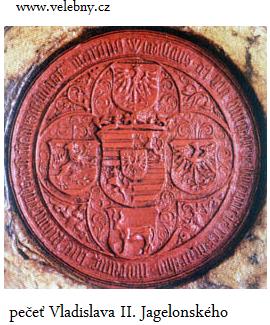
In the case of King Vratislaus I (+1092), there is doubt about the actual existence of his seal, i.e. whether the surviving undoubted falsetto had a genuine and, of course, unpreserved original, probably with a majestic theme.
After the news of Soběslav I's unpreserved seals spread, a continuous series of Bohemian sovereign seals began with Vladislav II. Originally a one-sided seal of St. Wenceslas, featuring a standing St. Wenceslas as the patron and eternal ruler of the Bohemian state, is replaced in the royal type of his seal by a coin seal, with the seated monarch in full majesty on the obverse and St. Wenceslas on the reverse. Wenceslas.
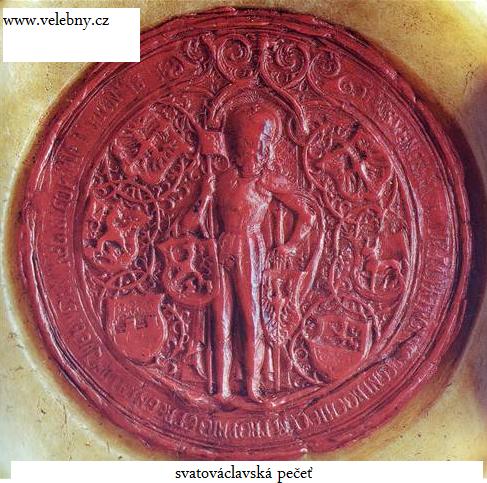
In the case of coin seals, the Přemyslid rulers remained (a peculiarity that can be observed more consistently in wax seals).only in some peripheral areas of Latin culture) already permanently, in the concrete filling occurs under Přemysl II. The St. Wenceslas side is replaced by the equestrian side.
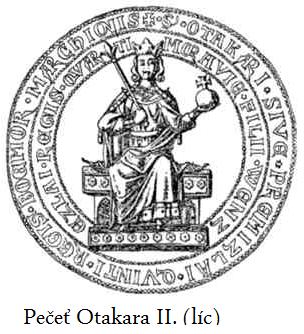
The St. Wenceslas motif is further applied only to the seals of the provincial court, which were initially probably used as a substitute for the seals of the absent secretary, and later as seals of the provincial court.
During the reign of Přemysl I, the golden bull of this monarch is found; it is the only exception among Bohemian monarchs, unless they were also Roman rulers. The rulers of the interregnum 1306- 1310 use only secreta.
The Luxembourgers, after a brief continuation of earlier developments, introduced a one-sided equestrian seal from about 1323 and a majestic seal with a possible secret on the dorso from 1346. At this time, the ruler's seals are more varied, with smaller, secret seals appearing alongside the majestic ones. We also encounter seals of various court and provincial offices.
In the Hussite period, the type of majestic seals disappears for a while and is replaced by seals of arms (it concerns George of Poděbrady and both Jagiellons). During the reign of the Habsburgs, the majestic seals were restored and other types were extended.
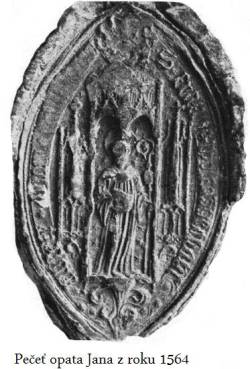 The second basic category in the chronological list of Czech seals is Bishop's seals. After the uncertain data on Vojtěch and the seals of the Prague bishops of the late 11th and first half of the 12th century. The seals of the bishop of Prague Daniel I (1148- 1167) and in Moravia of the bishop of Olomouc Jindřich Zdík (1126- 1150) show some evidence. Initially, however, these were only used in a spiritual sense and not as authentic seals, which they became only in the 13th century. In the 18th century, their number increased, both for individuals and institutions (mostly pictorial seals with ourdivine themes), but in the following century their use became universal. However, the Hussites dealt them a blow from which the clerical seal in our country has not recovered as far as their general significance is concerned.
The second basic category in the chronological list of Czech seals is Bishop's seals. After the uncertain data on Vojtěch and the seals of the Prague bishops of the late 11th and first half of the 12th century. The seals of the bishop of Prague Daniel I (1148- 1167) and in Moravia of the bishop of Olomouc Jindřich Zdík (1126- 1150) show some evidence. Initially, however, these were only used in a spiritual sense and not as authentic seals, which they became only in the 13th century. In the 18th century, their number increased, both for individuals and institutions (mostly pictorial seals with ourdivine themes), but in the following century their use became universal. However, the Hussites dealt them a blow from which the clerical seal in our country has not recovered as far as their general significance is concerned.
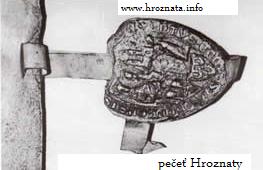
The first mention about seals of nobility dates back to 1189, when the seal of the nobleman Hroznata is mentioned in a coroboration of the monarch's charter. It was not until the following century that they came into more common use, in line with the nobility's attitude towards written acquisition. Thematically, these are mainly character seals, but also to a lesser extent equestrian and other seals. Other types of seals are exclusively in Latin, but national languages (Czech, German) were also used from the 13th century onwards, albeit rarely.
The last to appear are the seals of the towns - 1247 Brno, 1251 Litoměřice, 1257 Menší and 1264 Old Town of Prague, then their number increases and in the 14th century the seal can be assumed for all towns and cities, even the serfs. The chronological order of preservation does not necessarily imply the age of occurrence, but it is almost certain that it cannot differ much from the age of their origin. Only village seals appear later.

From the 14th century onwards, the use of seals in all legal forums became quite common, and seals were possessed even by officials of lesser importance. Seals began to gain ground (in terms of their authentication function) from the last century onwards.
I. Hlaváček, J. Kašpar, R. Nový.
You can search for artefacts from this period using our metal detectors.
The article is included in categories: